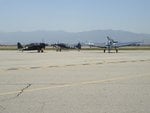Glider
Major
The Colossus and Majestic classes were really good examples of someone sitting down with a problem and coming up with a pragmatic solution. Its an interesting story which I have outlined below.
The RN needed carriers and they needed them quickly. We didn't have the Naval shipyards to build sufficient numbers of large carriers. The CVEs which as we know were basically converted merchant ships were coming on stream, were serving well but were of course too small and slow.
So the design for the Colossus was finalised.
The ships were built to Merchant Navy standards enableing them to be built in non naval shipyards.
The non armour protection, compartmentation, damage control, sprinklers, fireproof curtains, ventilation etc was as good as the best but the armour was missing.
The engines were standard destroyer engines and machinery for ease of supply
AA defense was very good but only short range. The carriers main AA defence was its aircraft, secondly its escort then its AA. They didn't carry any 20mm just 40mm and 2pdr. 20 mm lack the range to hit and destroy an attacking plane before it drops its weapons, hence the emphasise on the 40mm guns.
As a result you had a small ship that could carry a good number of aircraft at speed to keep up with our capital ships of the time. It was also cheap and easy to produce.
Its a formula that worked as after the war a number were purchased by other countries.
France, Netherlands, Australia, Argentina, India, Brasil all bought examples.
The RN needed carriers and they needed them quickly. We didn't have the Naval shipyards to build sufficient numbers of large carriers. The CVEs which as we know were basically converted merchant ships were coming on stream, were serving well but were of course too small and slow.
So the design for the Colossus was finalised.
The ships were built to Merchant Navy standards enableing them to be built in non naval shipyards.
The non armour protection, compartmentation, damage control, sprinklers, fireproof curtains, ventilation etc was as good as the best but the armour was missing.
The engines were standard destroyer engines and machinery for ease of supply
AA defense was very good but only short range. The carriers main AA defence was its aircraft, secondly its escort then its AA. They didn't carry any 20mm just 40mm and 2pdr. 20 mm lack the range to hit and destroy an attacking plane before it drops its weapons, hence the emphasise on the 40mm guns.
As a result you had a small ship that could carry a good number of aircraft at speed to keep up with our capital ships of the time. It was also cheap and easy to produce.
Its a formula that worked as after the war a number were purchased by other countries.
France, Netherlands, Australia, Argentina, India, Brasil all bought examples.

